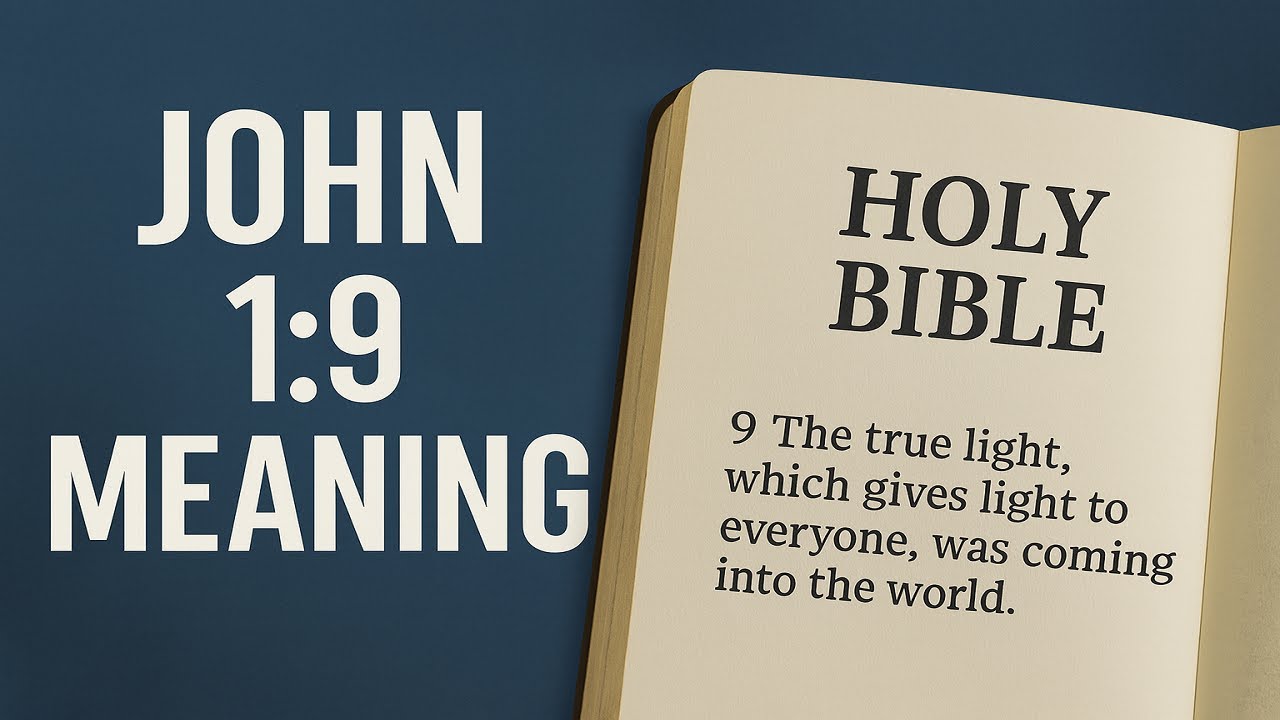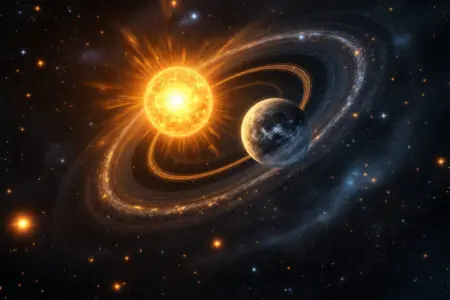Have you ever been in truly, profoundly dark place? I’m talking about the kind of blackness that swallows everything, where you can’t even see your own hand in front of your face. I have. It was during a power outage on a camping trip, deep in the woods. Instantly, everything familiar became strange. Every rustle of leaves morphed into a potential threat. I felt a raw, primal disorientation. In that moment, the smallest flicker of light would have been a miracle. That feeling—that desperate need for light when you’re overwhelmed by darkness—is the perfect entry point for understanding the John 1:9 meaning.
The Apostle John, in the incredible opening to his Gospel, isn’t just waxing poetic. He’s making one of the boldest claims ever put to paper. He writes, “The true light that gives light to everyone was coming into the world.” That one sentence is a theological bombshell, packed with meaning that has fascinated thinkers and changed lives for centuries. It’s a powerful statement about identity, purpose, and reality itself. It tells us that into our own spiritual and moral darkness, a perfect, universal light has arrived. This article is all about what that means for you and me, right here.
More in John Chapter 1 Category
Key Takeaways
- The Real Deal: John 1:9 points to Jesus as the “true light,” setting Him apart from all other prophets or philosophies. They might reflect light, but He is the source.
- An Open Invitation: This light isn’t for a select few. The verse says it “gives light to everyone,” signaling a universal grace and truth available to all of humanity.
- More Than Just Facts: The light Jesus brings isn’t merely intellectual. It’s the light of truth exposing lies, the light of moral guidance showing us the right way to live, and the light of life itself that pushes back against spiritual death.
- A Choice Is Required: While the light shines for all, the surrounding verses make it clear that an individual has to receive it. Its presence demands a decision: stay in the familiar darkness or step into the revealing light.
What Does It Really Mean to Be the “True Light”?
It’s so easy to skim past the word “true” and completely miss the punch John is throwing. The original Greek word here is alēthinon. It means more than just “not false.” It carries the weight of being the genuine article, the real thing, of which everything else is just a copy or a shadow. John is drawing a line in the sand. Our world has countless “lights”—philosophies, religions, gurus, even our own bright ideas. They can offer some illumination. They might even help a little.
But they are not the source.
John the Baptist is the primary case study. He was a bright and shining lamp, no doubt about it. Jesus himself said so. People were drawn to his message. But the Apostle John is crystal clear: the Baptist was not that light. He came to point to it.
So, John the Baptist Wasn’t a Light?
Oh, he was a light, and a powerful one. But he was a dependent light. Think about the moon. On a clear night, it can be breathtakingly bright, lighting up the whole landscape. It’s beautiful. It helps you see. But the moon has no light of its own. It’s just a rock reflecting the glory of a far greater source—the sun.
That was John the Baptist. He was the moon, perfectly reflecting the coming Son. His job wasn’t to gather a following for himself, but to turn everyone’s attention to the real, source-light that was just beginning to crest the horizon. Jesus is the sun. He’s the self-generating, all-powerful, life-giving source of all spiritual light and truth. Every other prophet and teacher is, at best, a moon or a star, shining with borrowed brilliance.
How Can This One Light Illuminate Everyone?
This is where the verse goes from a bold claim to a universal one. “That gives light to everyone.” Not just one group of people. Not just the spiritually inclined. Not just future believers. Everyone. How is that possible? People have debated this for ages, but its power is in that radical scope. This light is more than a sermon you hear with your ears; it’s an illumination that happens on the inside. It’s the idea that God hasn’t left any of us to stumble in total darkness.
I think back to my early twenties. I had just finished college with a degree I wasn’t sure I wanted and felt completely lost. The world seemed like a maze of options, and none of them felt right. The pressure to have my life figured out was crushing. It was a time of deep internal darkness. I really wrestled with my faith then.
A verse like John 1:9 didn’t magically produce a five-year plan. It did something far more important. It became a kind of internal compass. The knowledge that a “true light” was shining—and was available to me even in my confusion—gave me a sense of direction. It was a quiet promise that truth and meaning were real, even if I couldn’t see the whole road ahead. It was just enough light for the next step. That was all I needed.
Does This Mean Everyone Is Automatically Saved?
This is a really important distinction to make. The light being available to everyone doesn’t mean everyone automatically accepts it. A lighthouse can sweep its beam across a stormy sea, offering a safe path to every single ship. But a captain can still choose to ignore that light and wreck his vessel on the rocks. John explains this tragic reality just a few verses later: “He was in the world, and though the world was made through him, the world did not recognize him. He came to that which was his own, but his own did not receive him” (John 1:10-11).
The light shines on all. It informs every person’s conscience. It gives us an innate moral sense. It’s why we know, deep down, that love is better than hate and that justice is better than cruelty. Some theologians call this “general revelation.” But to truly benefit from the light, to be saved by it, you have to consciously receive it and the one who brings it.
What Kind of “Light” Is John Talking About?
When John uses the word “light,” he’s tapping into a rich metaphor his audience would have instantly grasped. This isn’t just about intellectual enlightenment or a new set of rules. This light is active and life-changing. Let’s break it down:
- Light as Truth: Darkness is the home of confusion and deception. You can’t be sure of what you’re seeing. Light, on the other hand, reveals. It shows things as they really are. The light of Christ slices through our favorite self-deceptions, our cultural narratives, and our spiritual lies. It shows us the truth about God, about the world, and—most uncomfortably—about ourselves.
- Light as Guidance: Ever tried to walk through a messy room in the pitch black? You stumble over things, you bump into walls. That’s a perfect picture of trying to navigate life without God’s guidance. The light of Christ is a moral compass. It lights up the path of wisdom and integrity, showing us where to step to avoid the hazards of sin and self-destruction. As the Psalmist put it, it is “a lamp for my feet, a light on my path” (Psalm 119:105).
- Light as Life: In our physical world, light is non-negotiable for life. Without the sun, everything on this planet would die. John makes a direct link between light and life. In verse 4, he writes, “In him was life, and that life was the light of all mankind.” The spiritual light that radiates from Jesus isn’t just data; it’s the very spark of spiritual life. It reanimates our spirits and plugs us into the vibrant, eternal life of God.
How Did Jesus’s Arrival Change Everything?
That phrase, “was coming into the world,” is huge. It points directly to the Incarnation—that mind-bending moment when God put on flesh and became a man in Jesus. It’s not that the world was pitch black before He arrived. God had shown flickers of His light through His creation, through the human conscience, and through the prophets and laws of Israel. But all of that was like the first hint of grey before the dawn.
Jesus’s arrival was the sunrise.
Suddenly, the full, unfiltered, and perfect revelation of God was here. God was no longer just a voice from a fiery bush or words carved on stone tablets. He was a person you could see and touch and listen to. If you wanted to know what God was like, you just had to look at Jesus.d to know hllow Jesus. you could follow Him. He was God’s complete and final word. man whago.
I saw this lived out in alive who mentored me years ago. His name was David, a humble mechanic who seemed to run on a different operating system than everyone else. While the rest of us were buzzing with anxiety, David had this deep reservoir of peace. His advice was never flashy, but it was always wise and drenched in love.
He didn’t need to preach; his life was the sermon. Being around him felt like stepping out of a dim, chaotic room into a calm, well-lit one. David was a reflection. He was a man who had opened his life so completely to the “true light” that he couldn’t help but glow with it. He showed me what a person illuminated bylike.
Is This Light Still “Coming” Today?
Absolutely. The historical event of the Incarnation is in the past, but the light’s entry into the world is an ongoing reality. That light now shines through the Holy Spirit living in believers. It shines through the words of Scripture. And it shines—imperfectly, to be sure—through the Church, the community of people called to be “the light of the world.” The mission goes on. We are now the moons, called to reflect the brilliant light of the Son into the dark corners of our world.
If thiht is so wonderf
Why Do People Reject This Light?
So if this light is so great and so available, why doesn’t everyone jump at the chance to embrace it? Why did His own people “notr in his g tacklesospel:into the world, but people loved darkn gospel: “And this isof l verdict: The light has come into theight because their deeds were evil” (John 3:19). The rejection of the light is rarely an intellectual problem.
It is a moral one.
The light is uncomfortable. It is revealing. A cockroach doesn’t scurry away when you flip on the light because it philosophically disagrees with the nature of photons. It runs because its nature is to dwell in the dark, and the light exposes it. In the same way, the light of Christ exposes the parts of our lives we would rather keep hidden: our pride, our selfishness, our greed, our secret sins. To embrace the light means being willing to have those things exposed and dealt with. For many, the familiar comfort of darkness feels safer.
Here are some reasons people choose darkness:
- A Preference for the Familiar: Sin and dysfunction can become comfortable. Stepping into the light requires change, and change is hard.
- Fear of Exposure: We fear that if our true selves are exposed, we will be judged or rejected. The darkness provides a cover to maintain our image.
- The Demands of Pride: The light reveals our need. It shows us that we are not okay on our own. Pride hates to admit need. It would rather stumble alone in the dark than ask for help and guidance.
How Can We Personally Experience This True Light?
Understanding the John 1:9 meaning is one thing; experiencing its reality is another. This isn’t just about agreeing with a set of theological propositions. It’s about a personal and transformative encounter. The path from darkness to light involves a few crucial steps, outlined right in John’s prologue.
First, we must acknowledge our own darkness. We have to stop pretending we have it all together and admit our need for illumination and guidance. Second, we must be willing to turn toward the light. This is the heart of repentance—a change of mind and direction. It means choosing to stop walking toward the darkness and instead turning to face the source of light. Finally, we must believe in and receive the one who is the Light.
John 1:12 says, “Yet to all who did receive him, to those who believed in his name, he gave the right to become children of God.” This is more than just intellectual belief; it’s an act of trust, of surrender, of opening the door of our lives to Him. For more insight into the profound identity of Jesus as the Word and Light, you can explore the theological concept of the Logos in John’s Gospel.
The Unquenchable Light
The meaning of John 1:9 is a message of immense hope. It declares that the default state of the universe is not darkness, but light. It tells us that no matter how deep the shadows in our own lives or in the world around us may seem, a true, genuine, and powerful light is shining.
This light is not a distant, philosophical concept. It is a person.
It is Jesus Christ, the one who stepped into our world to illuminate every human heart. He is the sun, not the moon. He is the source, not the reflection. His light exposes, guides, and gives life. It is a universal offer, a standing invitation to anyone who is tired of stumbling in the dark to step into the glorious freedom of His light.
FAQ – John 1:9 Meaning

How does Jesus’s arrival change the way we understand light and darkness?
Jesus’s arrival is described as the dawn that brings full and perfect revelation of God into the world. It transforms the partial and flickering light of previous prophets and laws into a bright, unfiltered illumination, revealing God’s nature and guiding humanity from moral and spiritual darkness into understanding and life.
Why do some people reject the light of Jesus despite its availability to all?
People often reject Jesus’s light because it exposes their sins and flaws, which can be uncomfortable and challenging to face. Many prefer the familiarity of darkness, which feels safe and private, rather than acknowledge their need for change and the demands of truth and moral guidance that the light reveals.
What does John 1:9 mean by referring to Jesus as the ‘true light’?
John 1:9 describes Jesus as the ‘true light,’ meaning He is the genuine, real source of spiritual illumination, unlike any other false or reflected lights. This signifies that Jesus is the ultimate source of truth, guidance, and life, illuminating the moral and spiritual darkness in the world.






